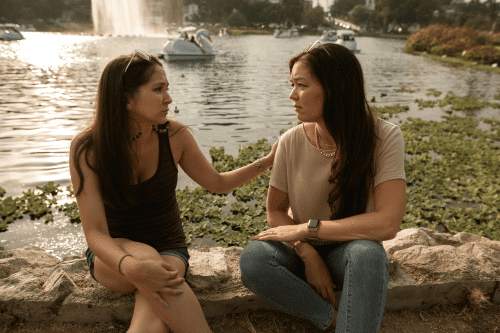
Free Call

Send Us A Message

3822 Campus Dr #300-B, Newport Beach
Loving a partner who struggles with addiction is one of the hardest things to experience. It feels isolating, confusing, and overwhelming. The pain you experience can pile even higher when the person you love refuses to get help.
If your partner with addiction won’t agree to treatment, you’re not alone, and you’re not powerless. This guide will walk you through what to do when an addict refuses help by giving you honest and compassionate advice to navigate the emotional weight of it all.
Bystander intervention is the act of stepping in when someone is at risk of harm. This includes responding to abuse, harassment, or violence in real time. The goal is to shift from passive observation to active helping.
The bystander effect is a psychological barrier that stops people from acting. When many people witness an incident, they assume someone else will intervene. This delay can worsen outcomes for victims.
The bystander effect explains why people often stay silent during crises. It reduces personal responsibility in group settings. People fear misjudging the situation or facing social backlash.

This behavior leads to inaction, even during clear cases of assault or abuse. Bystander intervention breaks this pattern by encouraging immediate, thoughtful responses. Education on these dynamics improves community safety.
Bystanders witness countless incidents of harassment, sexual abuse, or violence. Silence can reinforce harmful behavior. Intervention interrupts that cycle and shows victims they are not alone.
Taking action can prevent long-term trauma. Even small efforts—like distraction or direct comments—can reduce risk. Intervention builds safer schools, workplaces, and communities.
This method involves confronting the person causing harm. A direct statement, such as “That’s not okay,” can stop abusive behavior. It works best when the bystander feels safe to speak out.
Creating a diversion can stop an incident without confrontation. Dropping an item, starting a conversation, or redirecting attention are effective tactics. Distraction is useful in tense or escalating situations.
Sometimes, the best option is to seek help. This can include calling 911, contacting security, or notifying a supervisor. Delegation spreads responsibility and reduces individual fear.
If immediate action feels unsafe, checking in with the victim afterward still counts. Offering support or helping them report the behavior builds trust. Delayed responses still help reduce harm.
Being an active bystander means noticing when something is wrong and choosing to intervene. It takes awareness, confidence, and communication. People often miss cues due to fear or uncertainty.
Recognizing signs of abuse or harassment is the first step. These include body language, tone of voice, and changes in behavior. Attention to context helps determine when to act.
Practicing intervention techniques builds skill. Training can involve role-playing, conversation starters, and response planning. Confidence grows with education and support.

Fear often stops people from helping. They may worry about retaliation or making things worse. Fear of being wrong or embarrassed is also common.
Understanding that these fears are natural helps reduce their control. Intervention doesn’t require perfection—just effort. Even hesitation can shift to action with the right tools.
Overcoming fear is easier with preparation. By learning what to say and do, bystanders feel more capable. Support from peers also encourages intervention.
Sexual abuse and harassment are common but underreported. Bystander intervention helps close that gap. When someone steps in, it challenges the social norms that allow this abuse.
Education around consent, power dynamics, and respectful behavior is key. Intervening in jokes, unwanted touches, or inappropriate comments creates safer environments. Silence often protects the harasser.
Talking about these topics openly encourages cultural change. Schools and workplaces benefit from policies that support active bystander behavior. Long-term change starts with one voice.
Violence, whether verbal or physical, often escalates quickly. Early intervention can prevent serious harm. Recognizing warning signs like raised voices, threats, or physical aggression is critical.
Distraction or delegation are often safest in these cases. Removing potential victims from the area also reduces risk. When safety allows, direct confrontation may stop the aggressor.
It’s important to prioritize everyone’s safety. A well-timed call to emergency services can save lives. Trained professionals can take over when the risk is too high.
Intervention is not only for extreme cases. Everyday abuse or harassment—like bullying or rude jokes—also need responses. These smaller acts contribute to toxic behavior over time.
Starting a private conversation with the victim or the offender can create change. Helping isn’t always loud. A quiet word or gesture of support makes a difference.
Consistency matters. Frequent small interventions can change group behavior. Others may follow your lead once someone takes the first step.
Creating a culture where intervention is expected starts with education. Schools, workplaces, and families can teach these skills early. Conversations about values and responsibility matter.
Group trainings help normalize intervention. Seeing peers act reduces the fear of standing out. A shared commitment to safety strengthens the group.
When people feel empowered, they protect one another. This culture reduces abuse and increases community well-being. Everyone plays a part.
Sometimes, just starting a conversation is the intervention. Talking about inappropriate behavior later, in private, can change future actions. Respectful dialogue can reduce defensiveness.
Clear, calm language matters. Saying “I noticed that…” or “That seemed upsetting…” invites reflection without attack. This keeps the focus on behavior rather than character.
Ongoing conversations build understanding. Over time, this reduces the likelihood of repeated abuse or harassment. Language is a tool for positive change.

Education is the foundation of effective bystander intervention. Programs in schools and workplaces teach people how to identify and respond to risky behavior. Role-playing builds readiness.
Knowledge helps people overcome fear. It provides confidence in spotting and naming inappropriate conduct. Training also outlines options based on safety and context.
Continued awareness ensures people don’t forget what they’ve learned. Refresher sessions, posters, and discussions keep intervention skills sharp. Awareness campaigns improve outcomes for victims.
Some people feel it’s not their place to intervene. Others fear being judged or making mistakes. Lack of knowledge and unclear boundaries can block action.
These barriers are real, but not permanent. Learning, practicing, and witnessing positive intervention change behavior. Support from leadership also strengthens response rates.
Intervention should be viewed as normal, not exceptional. It shows care for others and creates safer communities. Barriers break when people believe they have a role.
At Addiction Interventions, we understand how silence enables abuse and violence. Our services include training for families and communities to spot early warning signs. We teach how to intervene before addiction or behavior problems escalate.
Substance abuse and violence often go hand-in-hand. Our professional interventionists use structured approaches to reduce harm. We guide families through fear and give them tools to act.
We also provide education on topics like harassment, psychological abuse, and risk prevention. Our goal is to turn bystanders into helpers. With the right support, anyone can learn to intervene.
Bystander intervention saves lives, protects dignity, and creates safer spaces. It challenges the silence that allows abuse, harassment, and violence to continue. The bystander effect loses power when people are trained and willing to act.
Everyone has a role in stopping harm. Whether through distraction, direct conversation, or delegation, action matters. Education, skill-building, and courage transform communities.
Support and resources are available. Organizations like Addiction Interventions offer help for those unsure how to intervene. Together, we can stop abuse before it grows.
Use age-appropriate language and scenarios. Teach them to seek help, speak up, and understand right from wrong. Role-playing can reinforce learning.
Your safety comes first. Use indirect methods like distraction or delegation. Always prioritize calling for help if a situation is dangerous.
Yes. Calling out harmful comments, reporting abuse, and supporting victims online are all forms of intervention. Digital behavior matters too.
Listen without judgment, offer resources, and ask what they need. Your support helps them feel seen and reduces the impact of trauma.






© 2025. Addiction Interventions. All Rights Reserved